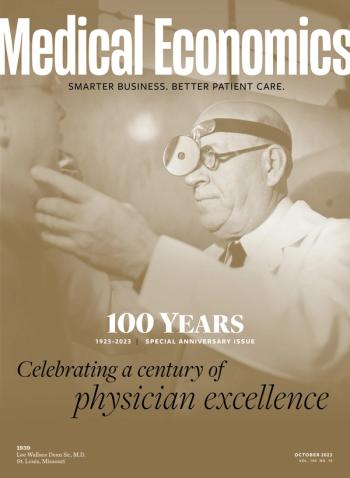
- Medical Economics October 2023
- Volume 100
- Issue 10
How modern medicine was made, part 2: The power of vaccination
'Church bells rang out'
In 1923, Physicians marked the centennial of the death of Edward Jenner, the English scientist who became the father of vaccination. Jenner coined the term from “vacca,” Latin for cow, because he observed that infection by cowpox created immunity to smallpox. By then, that disfiguring, deadly scourge was gone from many parts of the world.
By that same year, the French microbiologist Louis Pasteur’s rabies vaccine for dogs and humans was approaching 40 years old. In the United States, Congress in 1902 passed the Biologics Control Act, the first modern legislation to control drug quality, and in 1905 the Supreme Court upheld mandatory smallpox vaccination to preserve public health. The Spanish flu pandemic of 1918 was a recent memory. In the 1930s, the invention of electron microscopes allowed researchers to see and differentiate actual viruses.
“Before that, it was only assumed that a virus or a virus-type thing existed. They knew that something was being transmitted, but they were not able to see it,” says René Najera, M.P.H., Dr.P.H., director of the Center for Public Health and the History of Vaccines Project for The College of Physicians of Philadelphia. “It was just a tremendous leap that allowed for, finally, an understanding that not every respiratory infection was caused by the flu, that not every fever and rash was caused by measles, that there were all these other viruses going around.”
All that helped launch the next stage in vaccine research. But the ability finally to see viruses and differentiate them did not necessarily lead to results.
Thomas Francis Jr., M.D., an epidemiologist at the University of Michigan, led an early cohort of influenza researchers who differentiated the flu virus serotypes that were changing over time, discovering types A and B, says Lee Hampton, M.D., M.Sc., pediatrician and medical epidemiologist for Gavi, the Vaccine Alliance, in Switzerland.
“Those findings were actually devastating because they were hoping that they would be able to develop a universal flu vaccine that would cover all types of flu,” Hampton says. “They thought, there’s only one type of flu at the time and that would then allow you to just keep making vaccines that can provide protection to everybody. In other words, something kind of like our measles vaccine today.”
Differentiating viruses would be crucial in developing a vaccine for another disease — poliomyelitis, feared since it caused an outbreak in the United States in 1894. In 1921, it would afflict Franklin Delano Roosevelt as an adult. In 1938, he endorsed the National Foundation for Infantile Paralysis, known as the March of Dimes for the coins people sent to the White House for polio research.
After World War II, Francis’ protégé, Dr. Jonas Salk, would become a leader in polio research as parents across the nation suffered polio panics, especially in warm weather months. In 1952, the worst year, there were 57,628 reported cases, according to the History of Vaccines Project.
In April 1954, a polio vaccine trial began in the United States, with more than 1.3 million children participating, along with Salk, his wife and their children. Almost a year later, Francis, the influenza expert and Salk’s mentor, announced success.
In 1956, Paul A. Offit, M.D., now pediatrician and director of the Vaccine Education Center at the Children’s Hospital of Philadelphia and co-inventor of the RotaTeq rotavirus vaccine, was a child and was hospitalized for a foot operation — in a polio ward. He recalled seeing children in iron lungs and in traction. He called it “a nightmare.”
“When the polio vaccine came out, church bells rang out, synagogues held special prayer meetings, department stores announced that over the loudspeaker,” Offit says. “This country just stopped and celebrated that moment because we knew what polio was and we knew that now we had something in hand to prevent it. We had our ticket out of that — basically, a yearly epidemic. I think people forget just how powerful vaccines can be.”
That test was a landmark in the history of medicine for at least three reasons, Hampton says.
It provided confidence that the vaccine worked, contributing to its uptake. It started the U.S. National Immunization Program, now known as the National Center for Immunization and Respiratory Diseases. More generally, it set the standard of assessing new medical interventions by using large, well-publicized, randomized, controlled trials, Hampton says.
If Salk was the most famous vaccine researcher in the nation, Maurice Hilleman, Ph.D., quietly became the most prolific one, the modern father of vaccination. After 1957, while working at Merck & Co., the Montana native developed more than 40 vaccines, including eight of the 14 recommended for children in the United States.
Although highly esteemed and honored as a scientist, Hilleman never sought public recognition for work that saves an estimated 8 million lives a year. Those achievements are staggering, like trying to imagine a fifth dimension, says Offit, who also is a Hilleman biographer.
The experts agreed we will witness progress from a more recent breakthrough: using messenger RNA (mRNA) to prompt cells to create proteins that spur antibodies to fight off invading viruses. That research was happening for 30 years but came to the forefront in 2020, when the United States began Operation Warp Speed to create a vaccine against COVID-19.
Najera and Hampton says using mRNA vaccines will revolutionize the use of shots throughout the world because mRNA technology eliminates the need to grow some viruses to create vaccines. “The mRNA vaccines don’t have to be grown in a lab anymore. Now all you need is a genetic code,” Najera says.
As of 2023, smallpox is eradicated, as is the cattle disease rinderpest. Polio remains endemic in two countries, Pakistan and Afghanistan. Many more people need shots against numerous harmful diseases, and new discoveries await.
“The bad news is that we still have a lot of pathogens out there, a lot of germs that cause people to become ill and sometimes to die,” Hampton says. “There’s still a lot of scope to develop vaccines to deal with those types of pathogens.”
How modern medicine was made: Table of contents
Introduction Part 1: The importance of medical imaging Part 2: The power of vaccination Part 3: The history of antibiotic development Part 4: The importance of insulin's discovery Part 5: The development of surgery and organ transplantation Part 6: Military medicine advances health care for soldiers and civilians Conclusion: Improving lives
Articles in this issue
about 2 years ago
The future of medicine - what patients expectabout 2 years ago
The doctors bag in 2023about 2 years ago
The doctor's bag in 1923about 2 years ago
A century of primary care transformationNewsletter
Stay informed and empowered with Medical Economics enewsletter, delivering expert insights, financial strategies, practice management tips and technology trends — tailored for today’s physicians.


















